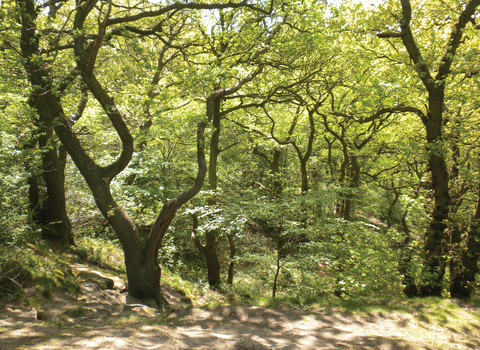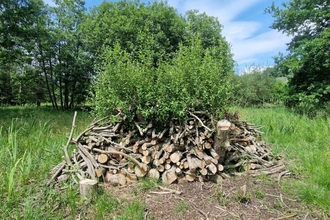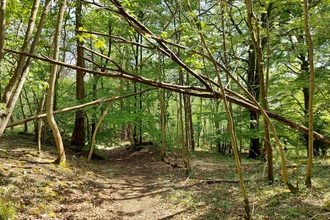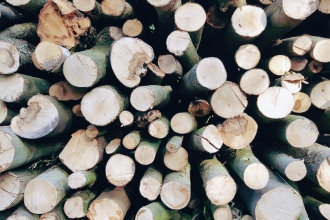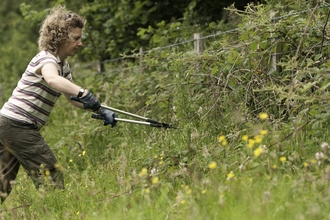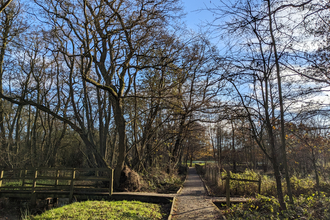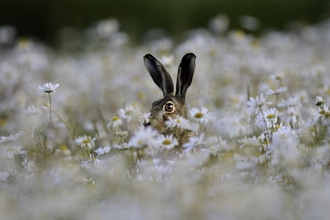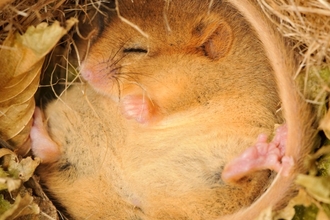Our woodlands
Yorkshire is home to a rich tapestry of woodlands that are not just beautiful but essential for wildlife and climate resilience. As the days grow shorter and the leaves turn golden, an autumn woodland walk is one of the most magical ways to experience a wilder Yorkshire.
Some of our favourites include glorious Grass Wood nature reserve, one of the largest areas of broadleaved woodland in the Dales; fungi-filled Hollinhurst Wood and sculptural ancient woodland Hetchell Wood nature reserves near Leeds.
Discover more of our favourites Woodland challenges and solutions
UK woodlands cover approximately 13% of land and are estimated to soak up around 21 million tonnes of carbon dioxide a year. That's around a third of the carbon dioxide emitted by cars every year in the UK!
In Yorkshire, our roots run deep
Yorkshire’s woodlands are more than just trees. They’re part of who we are. They hold our stories, our childhood adventures, our peaceful escapes. They are wild, wonderful, and woven into the very fabric of our landscape and identity.
But these precious places are under threat.
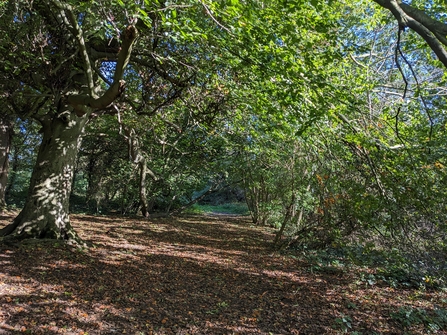
Just 8% of Yorkshire is covered with woodland
It may seem hard to believe, but it’s true. Over time, the gradual loss of our woodlands means that our woodland wildlife is living in smaller and increasingly more fragmented parcels.
Our woodlands face continuous challenges from inappropriate development, climate breakdown, pollution, disease, invasive species, and habitat fragmentation. They lack sufficient deadwood, veteran trees, open spaces, or diversity of tree species, and they are often poorly managed – it is estimated that around 30% of North Yorkshire’s woodland is not managed at all.
Without intervention, we will lose the incredible biodiversity our woodlands offer. Our woodland butterflies will vanish, no longer fluttering through open glades; many of our woodland-specific birds like willow tits, lesser spotted woodpeckers and pied flycatchers will struggle to survive. Bats will no longer whizz through the canopies, and our wonderful wealth of fungi – with all of their brilliant names – will fade into obscurity.
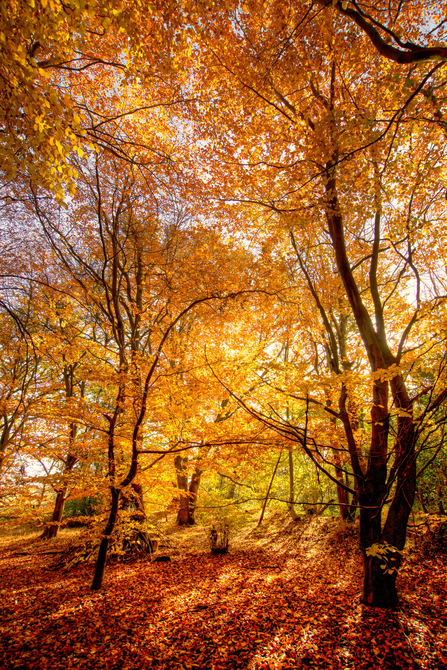
Don Sutherland
From tiny acorns, mighty oaks grow…
Though these threats are wide and varied, there is a glimmer of hope for the future of our woodlands. Yorkshire Wildlife Trust are proud to manage around 700 acres of woodland scattered throughout Yorkshire - almost double the size of Sherwood Forest.
From the rich and colourful North Cliffe Wood in the east, to the unique mires of Broadhead Clough in the west, the diversity of our woodlands also means that we are lucky enough to have some of the few remaining strongholds for rare and endangered species, from pied flycatchers and Nathusius’s pipistrelle to redstarts.
In the face of the numerous challenges our woodlands face, it’s essential that we can preserve, reinforce, and expand the reserves in our care to help every species not only to survive, but thrive.

brown long-eared bat in flight (c) Hugh Clark
Our aims are simple
Based on our new comprehensive Woodland Review, which has included a full suite of surveys across all of our woodland nature reserves, we will tackle the problems our woodlands face in a way that is tailored to their individual needs.
We are also hoping to work in partnership with local landowners to influence better management of woodland and trees across Yorkshire’s landscape.
In time and with the right strategies in place, we hope to see a resurgence in declining species like long-eared bats, tawny owls and maybe even pine martens.
Caring for Yorkshire's woodlands
Our woodlands play a crucial role in addressing climate change and flood control. Learn about the vital work we do to preserve and protect Yorkshire's woodlands, from habitat restoration and traditional management techniques to species monitoring and local community events.
A future rooted in our trees
Yorkshire Wildlife Trust’s woodlands span over 700 hectares across more than a hundred nature reserves — with 24% of our reserves fully or mostly wooded. However, only 8% of Yorkshire is covered by woodland — leaving precious little space for the extraordinary wildlife that depends on it.
Below are some of our most compelling and symbolic woodland species – beacons of what’s at stake and what can be saved.
Pied flycatcher
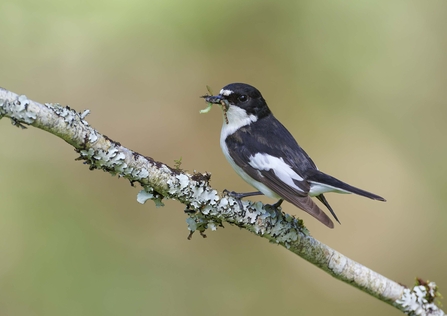
Pied flycatcher ©Richard Steel/2020VISION
The pied flycatcher is a small black and white bird commonly found in mature woodlands, with a particular preference for oak trees. Pied flycatchers are cavity nesters that like to take advantage of tree hollows, but also use nest boxes.
Since the late 1990s the pied flycatcher has experienced a 59% decrease in its UK population. This little bird is heavily impacted by climate change, as temperature fluctuations mean food sources in their wintering and rest locations are now available at the wrong time. As a result, pied flycatchers are now laying their eggs ten days later than in 1967 to ensure there are enough caterpillars for their chicks to survive, and their breeding range is moving further and further north towards cooler temperatures.
Where to spot them in Yorkshire, and what we're doing to help:
Birch Wood and Grass Wood both have small spring populations of pied flycatchers. We have added more nest boxes to the reserve to provide additional nesting sites, and have been conducting ongoing research to see what impact orientation makes on breeding success.
We hope that in time, woodland management at Little Beck Wood and Park Gill might lead to populations here too.
Nathusius’ pipistrelle bat
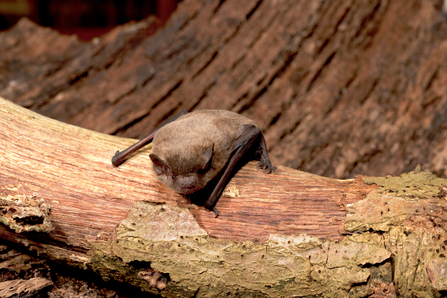
One of the UK’s rarest and least understood bats, Nathusius’ pipistrelle is a long-distance migrant, flying over 2000km across Europe each year. Bats rely on our woodlands to feed, rest and roost.
As woodland edges, wetlands, and rivers disappear or degrade under changing landscape using and climate change, our bats become more and more at risk from losing their safe havens.
Where to spot them in Yorkshire and what we're doing to help:
Look for bats at dusk around Potteric Carr and North Cave Wetlands, with recent emerging records from bat surveys at Filey Dams and Staveley. If you aren't an experienced bat-spotter, consider coming along to a bat walk event!
Our ongoing work to veteranise trees and create more deadwood is vital for making roosting spots and feeding space for bats, whilst our riverbank woodland restoration projects in places like the Upper Aire are vital for creating new feeding spaces.
Lesser spotted woodpecker
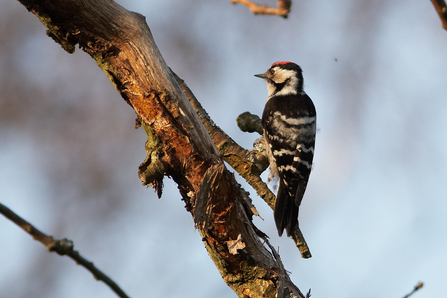
©Stefan Johansson
Often heard before seen, the lesser spotted woodpecker is the smallest and rarest of the UK's woodpeckers. There are now believed to be fewer than 1,000 pairs breeding annually in the UK, compared to 130,000 pairs of great spotted woodpeckers, and they rely on old, dying trees to nest and feed.
- Numbers have declined by 80% since the 1980s, and although breeding numbers seem better this year, 2024 was a catastrophic breeding year for lesser spotted woodpeckers. Without old trees and careful woodland management, our lesser spotted may become never spotted.
Where to see in Yorkshire and what we're doing to help:
We have records of lesser spotted woodpeckers at Adel Dam and Potteric Carr. Their 'drumming' is much quieter and less vigorous than that of the great spotted woodpecker, so you might only notice it by this sound.
Our ongoing work to leave deadwood in place and avoiding over-managed woodlands allows these birds to thrive, and we are mapping and monitoring breeding pairs to guide site-specific actions.
Long-eared bats
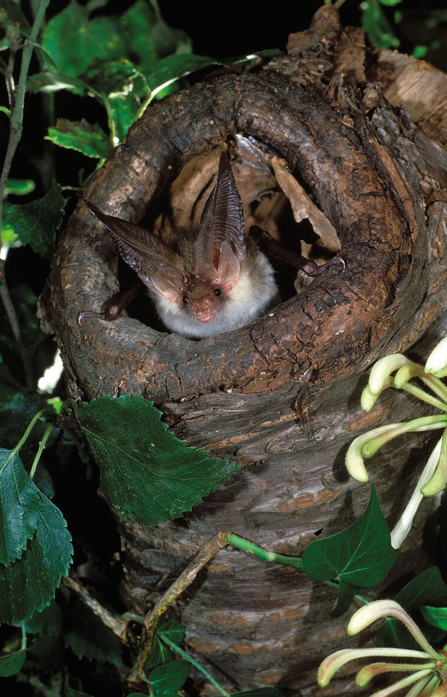
Credit: Hugh Clark
With ears nearly as long as their bodies, long-eared bats seem built for stealth. It's known as the 'whispering bat' because its voice is very quiet and difficult to pick up on a bat detector, and it often curls back or tucks its ears under its wings when resting. Their enormous ears give them exceptionally sensitive hearing – it can even detect the sound of a ladybird walking on a leaf!
Highly sensitive to disturbance and habitat fragmentation, long-eared bats are indicators of high-quality woodlands and increasingly rare. When their woodlands start to degrade, their populations quickly suffer.
Where to spot in Yorkshire and what we're doing to help:
Brown long-eared bats can be spotted at Staveley, Ripon City Wetlands, Moorlands and Filey Dams. The best time to see a brown long-eared bat is after sunset, when they leave their roosts to hunt. They usually follow linear features like streams, fences and hedges, and fly a bit slower than other bats.
We are working with landowners to preserve bat roosts in barns and trees, maintaining our own bat box programmes across our reserves, and at Moorlands and Potteric Carr, careful woodland management protects feeding corridors and old trees.
Tawny owls
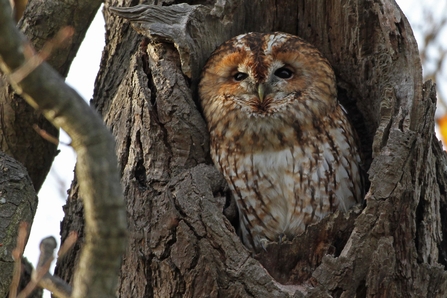
Tawny owl ©Margaret Holland
Tawny owls are the quintessential sound of the British night: “too-wit, too-woo.” Familiar yet fiercely territorial, tawny owls are iconic nocturnal hunters and our largest common owl.
Tawnies rely on mature trees for nesting, and a balanced ecosystem to support prey like voles and beetles. They nest in hollow trees during spring or sometimes reuse old crow’s nests. They are highly terratorial and mate for life, often returning to the same place to feed and hunt.
Where to find them in Yorkshire and what we're doing to help:
Tawny owls are widespread across mature woods like Little Beck and Askham Bog, but are also good to spot at Chafer Wood, Low Wood and Moorlands.
Our ongoing woodland management across all reserves ensures a mix of woodland ages and standing deadwood for nesting cavities, and we run owl pellet workshops and citizen science surveys to map food webs.
Find out more about tawny owls
Pine martens
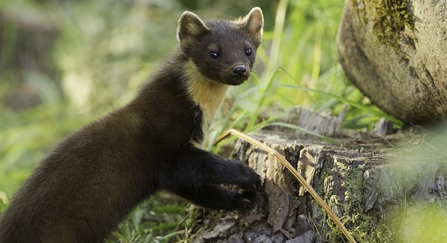
Pine marten © Mark Hamblin/2020VISION
Once lost from much of England, the pine marten is returning—quietly, stealthily, like a whisper in the trees. These cat-sized carnivores, with their chocolate fur and creamy bibs, are one of Britain’s rarest and most elusive mammals.
Their return signals not just species recovery, but woodland revival - pine martens need vast tracts of connected woodland to roam and den, making ancient and well-managed woods critical for their success.
Where to see in Yorkshire and what we're doing to help:
Pine martens are still rare in Yorkshire, although we do see the occasional visitor like the pine marten that visited Spurn Point back in 2023. With careful and considered management of our woodlands, our efforts could help to encourage this remarkable species recover from the brink and make its home in Yorkshire once again.
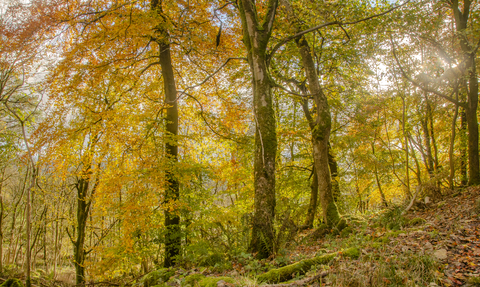
Autumnul Grass Wood (c) Sara
Give Yorkshire's woodlands a future
Branch out and get involved
From volunteering in our wonderful woodlands, to supporting our work through membership, there are many ways you can get involved.


